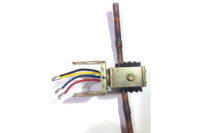Refrigeration service technicians often run service calls in which they find a compressor with a higher-than-normal suction pressure along with a lower-than-normal head pressure. Many times, the refrigeration equipment is still running, but the product temperature is too warm, which causes product quality and safety to suffer.
These calls are tough to handle because the compressor is still producing cooling but is not cooling to its rated capacity. In such cases, medium-temperature products will spoil quicker, and low-temperature products will not be frozen as solidly as they should be.
There are three main reasons a compressor will simultaneously have a higher-than-normal suction pressure with a lower-than-normal head pressure. They are:
- Bad (leaky) compressor valves;
- Worn compressor rings; and
- A leaky oil separator.
Let’s take a closer look at each one.
LEAKY COMPRESSOR VALVES
A compressor’s valves may become inefficient from being overheated and warped or having carbon and/or sludge deposits on them, which prevents them from sealing properly.
This can be caused by:
- Refrigerant migration problems;
- Refrigerant flooding problems;
- Acids and/or sludge in the system;
- An incorrectly set thermostatic expansion valve (TXV), which results in no superheat or too high superheat;
- An undercharge of refrigerant (high superheat);
- Overheating of the compressor;
- Slugging of refrigerant and/or oil; and
- Moisture and heat causing sludging problems.
Let’s consider a service call scenario in which the valves in a refrigeration system’s compressor are not sealing properly. The service technician measures the system’s temperatures and pressures and then calculates the condenser split and the condenser subcooling along with the evaporator and compressor superheat values. Both the measured and calculated values are shown here:
Measured Values
Compressor discharge temp: 280°F
Condenser outlet temp: 75°
Evaporator outlet temp: 25°
Compressor inlet temp: 55°
Refrigerated space temp: 25°
Compressor amperes: low
Low side pressure: 11.6 psig/10°
High side pressure: 95.0 psig/85°
Ambient temp: 80°
Calculated Values
Condenser split: 5°
Condenser subcooling: 10°
Evaporator superheat: 15°
Superheat at compressor (total): 45°
Symptoms
• Higher-than-normal discharge temperatures;
• Low condensing (head) pressures and temperatures;
• Normal to high condenser subcooling;
• Normal to high superheats;
• High evaporator (suction) pressures; and
• Low amp draw.
In analyzing the system in the given example, it’s important to understand how higher-than-normal discharge temperatures affect lubricants. The discharge temperature is measured 2 inches from the compressor. This would mean that the actual discharge valve temperature would be approximately 355° (280° + 75°, as adding 75° to the discharge line temperature reading will give the technician an approximate discharge valve temperature).
Mineral oil lubricants will start to decompose at 350° and polyolester lubricants at 400°. Any increase in temperature above these points causes polymerization of the oil. Polymerization is where the lubricant’s molecules start to combine into larger and larger molecules. The end product is thick, dark oil; then sludge; and finally a solid powder. This is referred to as oil breakdown. Compressor bearing failure and loss of lubrication to moving parts will occur from plugged oil inlet screens and oil galleys (lubrication passages) that are manufactured within the compressor. Oil sludge and other byproducts of oil breakdown can also attach themselves to internal surfaces, including the suction and discharge valves and valve plates. Figure 1 shows a normal valve plate with suction and discharge valves, and Figure 2 shows a valve plate with oil breakdown by-products on the valves and valve plate.
A discharge valve that isn’t seating properly because it has been damaged or sludged will cause the head pressure to be low. The reason is that refrigerant vapor will be forced out of the cylinder and into the discharge line during the upstroke of the compressor. On the downstroke, this same refrigerant that is now compressed in the discharge line will be drawn back into the cylinder because the discharge valve is not seating properly. This short-cycling of refrigerant will cause heating of the discharge gasses over and over again and cause higher-than-normal discharge temperatures. However, if the valve problem has progressed to where there is hardly any refrigerant flow rate through the system, there will be a lower discharge temperature from the extremely low flow rate.
Low Condensing (Head) Pressures — Once the compressor’s valves start to leak and some of the discharge gases are being short-cycled in and out of the compressor’s cylinder, there will be a low refrigerant flow rate through the condenser. This will make for a reduced heat-rejection load on the condenser and reduced condensing (head) pressures and temperatures.
Normal-to-high Condenser Subcooling — There will be a reduced refrigerant flow through the condenser — and, thus, through the entire system — because of system components being in series. Most of the refrigerant will be in the condenser and receiver. This may give the condenser a bit higher subcooling.
Normal-to-high Superheats — Because of the reduced refrigerant flow through the system, the TXV may not receive the refrigerant flow rate it needs. High superheats may be the result; however, the superheats may be normal if the valve problem is not severe.
High Evaporator (Suction) Pressure — Refrigerant vapor will be drawn from the suction line into the compressor’s cylinder during the downstroke of the compressor. However, during the upstroke, this same refrigerant may sneak back into the suction line because of the suction valve not seating properly from oil sludge or other oil breakdown byproducts adhering to its surface. The results are high suction pressures. Either suction or discharge valves may also be warped from a compressor overheating problem.
Low Amp Draw — Low amp draw is caused by the reduced refrigerant flow rate through the compressor. During the compression stroke, some of the refrigerant will leak through the suction valve and back into the suction line, which reduces the refrigerant flow. During the suction stroke, some of the refrigerant will sneak through the discharge valve because of it not seating properly and get back into the compressor’s cylinder. In both situations, there is a reduced refrigerant flow rate, which causes the amp draw to be lowered. The low head pressure that the compressor has to pump against will also reduce the amp draw.
WORN COMPESSOR RINGS
When the compressor rings are worn, high-side discharge gases will leak through them during the compression stroke and give the system a lower head pressure. Because discharge gases have leaked through the rings and into the crankcase, the suction pressure will also be higher than normal. The resulting symptom will be a lower head pressure with a higher suction pressure. The symptoms for worn rings on a compressor are very similar to leaky valves.
LEAKY OIL SEPARATOR
When the oil level in the oil separator becomes high enough to raise a float, an oil return needle is opened, and the oil is returned to the compressor crankcase through a small return line (see Figure 3).
The pressure difference between the high and low sides of the refrigeration system is the driving force for the oil to travel from the oil separator to the compressor’s crankcase. The oil separator is in the high side of the system, and the compressor crankcase in the low side. The float-operated oil return needle valve is located high enough in the oil sump to allow clean oil to automatically return to the compressor’s crankcase. Only a small amount of oil is needed to actuate the float mechanism, which ensures that only a small amount of oil is ever absent from the compressor crankcase at any given time.
When the oil level in the sump of the oil separator drops to a certain level, the float forces the needle valve closed. When the ball and float mechanism on an oil separator goes bad, it may bypass hot discharge gas directly into the compressor’s crankcase. The needle valve also may get stuck partially open from grit in the oil. This will cause high pressure to go directly into the compressor’s crankcase and cause high low-side pressures and low high-side pressures.













